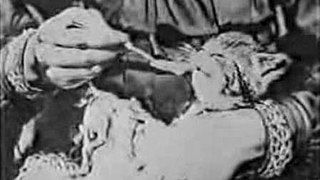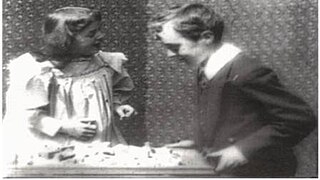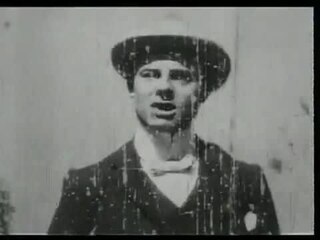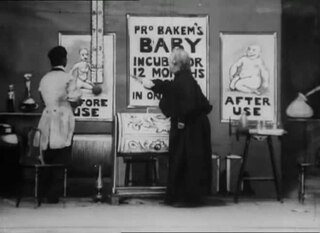Isadora Duncan, the Biggest Dancer in the World is a BBC Television film based on the life of the American dancer Isadora Duncan first broadcast on 22 September 1966. The film was directed and produced by Ken Russell and written by Sewell Stokes and Russell. It starred Vivian Pickles and Peter Bowles.

Grandma's Reading Glass is a 1900 British short silent drama film, directed by George Albert Smith, featuring a young Willy who borrows a huge magnifying glass to focus on various objects, which was shot to demonstrate the new technique of close-up. The film, according to Michael Brooke of BFI Screenonline, "was one of the first films to cut between medium shot and point-of-view close-up. It was destroyed in a fire at Warwick Trading Company's studio facility in 1912.

As Seen Through a Telescope is a 1900 British short silent comedy film, directed by George Albert Smith, featuring an elderly gentleman getting a glimpse of a woman's ankle through a telescope. The three-shot comedy, according to Michael Brooke of BFI Screenonline, "uses a similar technique to that which G.A. Smith pioneered in Grandma's Reading Glass (1900)," and although, "the editing is unsophisticated, the film does at least show a very early example of how to make use of point-of-view close-ups in the context of a coherent narrative ." "Smith's experiments with editing," Brooke concludes, "were ahead of most contemporary film-makers, and in retrospect it can clearly be seen that he was laying the foundations of film grammar as we now understand it."

The Kiss in the Tunnel, also known as A Kiss in the Tunnel, is a 1899 film British short silent comedy film, produced and directed by George Albert Smith, showing a couple sharing a brief kiss as their train passes through a tunnel, which is said to mark the beginnings of narrative editing. The film is the first to feature Laura Bayley, Smith's wife.

The Sick Kitten is a 1903 British short silent comedy film, directed by George Albert Smith, featuring two young children tending to a sick kitten.

The House That Jack Built is a 1900 British short silent drama film, directed by George Albert Smith, featuring a boy who knocks over a house made of bricks built by his sister and then rebuilds it when the original sequence is shown in reverse. "In addition to exploiting a popular cinematic trick," of, "reversing the film in the projector," and, "its audience's presumed knowledge of the technique," the director, according to Michael Brooke of BFI Screenonline, "was continuing his experiments with narrative forms," with the reversed sequence, "interpreted as wish-fulfilment on the part of the girl, hoping that time will literally turn back on itself to allow her house to be rebuilt," he, "demonstrates that while this is impossible in reality, it is easily achievable in cinema."
Othello is a 1990 film produced by the Royal Shakespeare Company, starring Ian McKellen, Willard White, Imogen Stubbs, and Zoë Wanamaker. It is based on a stage production of William Shakespeare's play Othello, directed by Trevor Nunn, and later rethought for TV and filmed in a studio. It was shot in a black box theater, so minimal props or scenery were needed, and aired 23 June 1990 on Theatre Night.

Woman Draped in Patterned Handkerchiefs is a 1908 British short silent documentary film, directed by George Albert Smith as a showcase of his new Kinemacolor system, which features a woman displaying assorted tartan cloths, both draped on her body and waved semaphore-style. The patterned handkerchiefs are, according to Michael Brooke of BFI Screenonline, "presumably the same cloths featured in Tartans of Scottish Clans (1906), this time shown from various angles."

Spiders on a Web is a 1900 British short silent documentary film, directed by George Albert Smith, featuring a single shot close-up of two spiders trapped in an enclosure. The film is, according to Michael Brooke of BFI Screenonline, "less formally ambitious," than the director's, "groundbreaking multiple close-up study Grandma's Reading Glass (1900), made the same year, but is nonetheless, "one of the earliest British examples of close-up natural history photography, predating Percy Smith's insect studies by a decade."

The X-Rays is an 1897 British short silent comedy film, directed by George Albert Smith, featuring a courting couple exposed to X-rays. The trick film, according to Michael Brooke of BFI Screenonline, "contains one of the first British examples of special effects created by means of jump cuts" Smith employs the jump-cut twice; first to transform his courting couple via "X rays," dramatized by means of the actors donning black bodysuits decorated with skeletons and with the woman holding only the metal support work of her umbrella, and then to return them and the umbrella to normal. The couple in question were played by Smith's wife Laura Bayley and Tom Green.

The Big Swallow is a 1901 British short silent comedy film, directed by James Williamson, featuring a man, irritated by the presence of a photographer, who solves his dilemma by swallowing him and his camera whole. The three-shot trick film is, according to Michael Brooke of BFI Screenonline, "one of the most important early British films in that it was one of the first to deliberately exploit the contrast between the eye of the camera and of the audience watching the final film".

Undressing Extraordinary is a 1901 British short silent comedy film, directed by Walter R. Booth, featuring a tired traveller struggling to undress for bed. The film, "provides one of the earliest filmed examples of something that would become a staple of both visual comedy and Surrealist art: that of inanimate objects refusing to obey natural physical laws, usually to the detriment of the person encountering them," and according to Michael Brooke of BFI Screenonline, "has also been cited as a pioneering horror film," as, "the inability to complete an apparently simple task for reasons beyond one's control is one of the basic ingredients of a nightmare."

The Waif and the Wizard, also entitled The Home Made Happy, is a 1901 British short silent comedy film, directed by Walter R. Booth, featuring a magician using his magic to aid an ailing girl at the request of her brother. The film, "is rather less elaborate in terms of special effects than the other films that W.R. Booth and R.W. Paul made the same year," but according to Michael Brooke of BFI Screenonline, "provides an excellent illustration of how effects used sparingly can often have more impact, especially when set in a suitable emotional context."

An Over-Incubated Baby is a 1901 British short silent comedy film, directed by Walter R. Booth, featuring a woman who gets an unpleasant surprise after placing her baby in Professor Bakem's baby incubator for 12 months growth in one hour. The film is, "one of the most original of the trick films made by W.R. Booth and R.W. Paul in 1901," and according to Michael Brooke of BFI Screenonline, "one of the less elaborate films made by Booth and Paul that year," "though the concept itself is so imaginative that it arguably didn't need any more than basic jump-cut transformations."

Cheese Mites, or Lilliputians in a London Restaurant is a 1901 British short silent comedy film, directed by Walter R. Booth, featuring a gentleman being entertained by the little people who emerge from the cheese at his table. The film, "contains a reference to Jonathan Swift's satirical novel Gulliver's Travels (1726)," and is, according to Michael Brooke of BFI Screenonline, "sophisticated in that he combined the jump-cut with superimposition."

The Countryman and the Cinematograph is a 1901 British short silent comedy film, directed by Robert W. Paul, featuring a stereotypical yokel reacting to films projected onto a screen. The film, "is one of the earliest known examples of a film within a film," where, according to Michael Brooke of BFI Screenonline, "the audience reaction to that film is as important a part of the drama as the content of the film itself."

Artistic Creation is a 1901 British short silent comedy film, directed by Walter R. Booth, featuring a lightning sketch artist drawing a picture of a woman which comes to life piece by piece. The film, "is one of the earliest examples of a film about an artist's creations coming to life," and according to Michael Brooke of BFI Screenonline, "a metaphorical cautionary tale about the responsibilities that should be borne by both creative artists and indeed the male sex in general."

The Haunted Curiosity Shop is a 1901 British short silent horror film directed by Walter R. Booth, featuring an elderly curio dealer alarmed by various apparitions that appear in his shop.

The Extraordinary Waiter is a 1902 British short silent comedy film, directed by Walter R. Booth, featuring a brutish colonialist failing to destroy a blackfaced waiter. The film, "makes for somewhat uncomfortable viewing," but according to Michael Brooke of BFI Screenonline, "it's just about possible to read this as a metaphor for the rather more widespread frustrations arising from British colonial rule, though it seems unlikely that this was intentional on Booth's part."

Willie's Magic Wand is a 1907 British short silent comedy film, directed by Walter R. Booth, featuring a young boy terrorising the household with his father's magic wand. Similar to "earlier trick films The Haunted Curiosity Shop and Undressing Extraordinary ," this is, according to Michael Brooke of BFI Screenonline, "essentially a series of [loosely linked] special-effects set pieces," however, "the print in the National Film and Television Archive is incomplete, omitting amongst other things a come-uppance where Willie is punished for his misdemeanours by being turned into a girl, thus depriving him of more than one magic wand." A clip from the film is featured in Paul Merton's interactive guide to early British silent comedy How They Laughed on the BFI website.


















